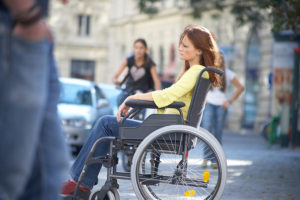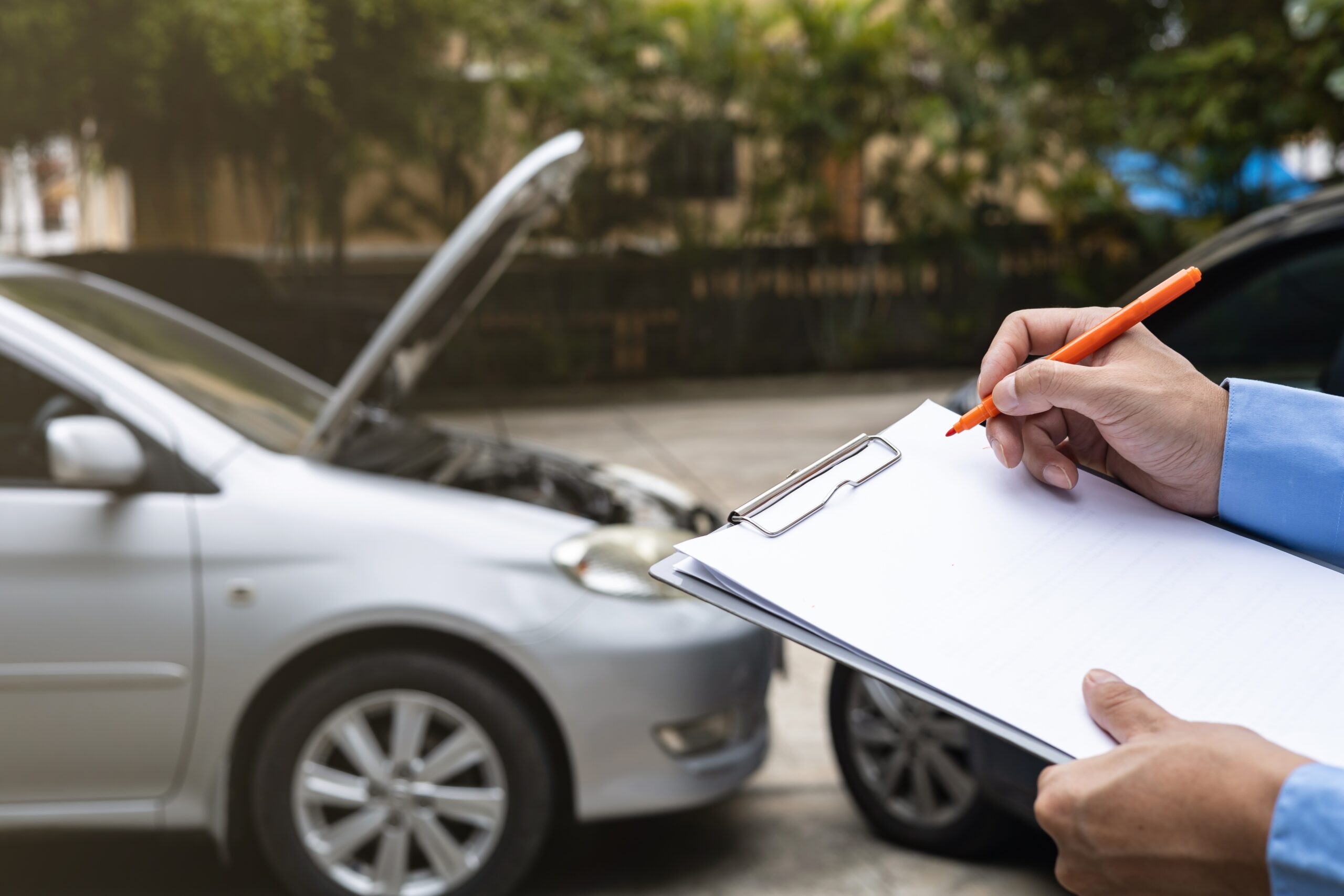The proverbial banana peel or ice-slick sidewalk in cartoons can be the source of much laughter. But in real life, slips and falls often cause catastrophic injuries, most notably permanent paralysis.
Falls are one of the leading causes of permanent paralysis due to injury to the spine. Tragically, most of these falls are preventable and caused by someone other than the victim.
Falling Accidents that Lead to Paralysis

Several types of force can damage the spinal cord, including twisting, bending, and blunt-force trauma. A fall victim may experience each of these types of spinal injuries in many different situations. It is possible that these spinal cord injuries result in permanent paralysis.
Fall from a High Place
Multistory buildings with improper safeguards can lead to falls from high places. Workers who perform their duties high above the ground risk falling if safety measures are not adequately employed or observed.
Blunt-force trauma from the impact can shatter the spinal column and cause bone fragments to pierce or even sever the spinal cord. The victim might also suffer extreme bending and twisting, which can snap the cord.
Slip and Fall
Individuals walking up patio stairs or down aisle seven at the local grocery have faith that the walkways they transit are safe, as they should. Unfortunately, some property owners and tenants fail to maintain their premises in a way that does not put the public at risk.
Depending on the situation, a victim of a slip and fall accident could experience one or all three of the forces typical in falls, resulting in damage to the spinal cord.
Fall Accidents and Paralysis
Fall accidents can lead to four main types of permanent paralysis. The nature of the fall and impact are highly determinative of the kind of paralysis and the post-accident treatment of the victim.
The four main types of paralysis are:
- Hemiplegia: Paralysis affecting only one side of the body
- Monoplegia: Paralysis affecting only one limb
- Paraplegia: Paralysis affecting both legs and possibly the torso
- Quadriplegia: Paralysis affecting all four limbs
Diplegia is another type of paralysis that someone might sustain in a fall. It refers to paralysis that affects the same location on both sides of a victim’s body. Generally speaking, the higher along the spinal cord the damage occurs, the more extensive the paralysis is likely to be.
Implications of Permanent Paralysis
Spinal cord injuries require extensive medical treatment. When permanent paralysis is the outcome, the dollar amounts needed for care and associated expenses skyrocket. There is also a heavy emotional and psychological toll when adapting to life with permanent paralysis.
Medical Care
From the time of the injury and throughout the length of the paralysis, spinal cord injury victims need specialized care that is often prohibitively costly.
Some of the expensive costs spinal cord injury victims face include:
- Emergency medical transportation costs
- Surgeries
- Hospital stays
- Rehabilitation regimens with physical and occupational therapists
- Prescription medication
The average spinal cord injury victim spends approximately $150,000 for just their first 15 days of treatment immediately following an injury. After that, their costs for one year of medical care can reach $200,000. For younger victims, the aggregate life costs are astronomical.
There’s also the issue of medical equipment. Individuals with paralysis must acquire specialized medical equipment and devices to get around and perform routine daily tasks. If the person has quadriplegia, the equipment demands will be high.
Individuals with permanent paralysis will likely need some of these expensive devices:
- Wheelchairs
- Scooters
- Walkers
- Braces
- Reachers
- Adaptive utensils, writing implements, and other tools
- Breathing and respiratory equipment
They may also need to make costly modifications to their homes or vehicles.
Work Implications
Permanent paralysis reduces most people's ability to perform their jobs as competently as before their injury.
Even if paralysis does not ultimately interfere with your ability to do your job directly, as in the case of a writer who develops paraplegia, the initial accident and recovery time will likely prevent you from earning a living wage.
Home Care
Fall victims suffering permanent paralysis almost invariably need assistance doing the tasks they once performed without aid. If the victim was a primary caregiver for children or adults, the costs required to hire outside help could be substantial.
Some of the household tasks that may be out of reach for people living with permanent paralysis include:
- Meal prep
- Grocery shopping
- Housecleaning and laundry
- Lawn care and gardening
If you are a caregiver for a child or an adult in your home, you may also need outside help to care for them. After paying these expenses for an extended period, your resources may be significantly depleted. However, your quality of life depends on regularly completing these simple tasks.
Non-Economic Losses
Permanent paralysis also causes non monetary losses. The law recognizes physical pain and suffering, mental anguish, and the loss of your ability to enjoy life. It also recognizes non-financial damages, such as scarring and disfigurement.
Although we cannot put ourselves in the shoes of a person with permanent paralysis, we might understand how paralysis affects mental and emotional health, and could lead to depression, anxiety, and an appreciable loss of quality of life.
Compensation for Falls Leading to Paralysis
The falls people experience are often not their fault—they are frequently preventable and only occur due to negligence on someone else’s part. As such, the law gives people with paralysis the right to seek compensation to offset their financial burdens, which can easily reach hundreds of thousands of dollars.
According to the Christopher & Dana Reeve Foundation, the lifetime costs of living with paralysis usually reach millions. For a 25-year-old victim, the lifetime costs for paraplegia are over $2.5 million, not including lost wages or other expenses. For a person with quadriplegia of the same age, the figure is between $3.7 and $5.1 million.
The first step down the path to compensation requires the victim's slip and fall attorney to demonstrate liability.
Premises Liability
Premises liability refers to accidents that happen on property not owned by the person who is injured. As mentioned earlier, slip and fall accidents are typical examples of premises liability accidents. When an injury occurs in this fashion, the owner or tenant in charge of the property becomes the primary focus of the liability inquiry.
What condition caused the accident and the spinal cord injury? A spinal cord injury lawyer will seek to answer this question.
Maybe the accident resulted from an unmarked spill that an organization's staff failed to clean, or perhaps the cause was a rotten staircase step that gave way. Whatever the reason, your attorney must show evidence of it.
The likelihood of a camera capturing a fall accident keeps increasing thanks to the commonplace nature of cameras in modern businesses and other buildings. Personal injury attorneys may rely on video footage and photos in many types of fall cases.
Sites or locations that are likely to have video or still cameras in use include:
- Residential buildings
- Retail businesses
- Government buildings
- Single-family homes
Other places your attorney might search for footage of an accident include dashcam videos, traffic cams, and even cell phones.
With clear and direct video footage of an incident leading to a fall and severe spinal injury, liability is much easier to prove, which leads to faster claim resolution. Sometimes, you will need a skilled attorney to obtain video evidence.
Product Liability
You may hold each business responsible for putting unreasonably dangerous products in the hands of consumers liable for its oversight. In the case of falls, various products may suffer defects that put consumers at imminent risk of harm. Items such as ladders, stools, and portable steps may exhibit manufacturing flaws that increase fall risks.
Who your personal injury attorney pinpoints as liable depends on the facts of your case. For example, the manufacturer would likely be to blame for a ladder made with defective parts. Or an improperly designed ladder with a dangerous flaw might put the designer on the hook.
In most jurisdictions around the country, businesses are strictly liable for the injuries their products cause, which means your personal injury lawyer need not demonstrate negligence. However, Virginia laws require plaintiffs to prove that negligence was involved.
Timing Considerations
Timing considerations require spinal cord injury victims to act quickly when seeking compensation. One of the most important is the statute of limitations, which is the time victims have to file a compensation claim.
In Virginia, you must file your claim within two years of the injury, or it will likely become invalid. Although this regulation has some exceptions, most cases must be pursued before the two years have elapsed.
Another thing fall victims should consider is how the passage of time might weaken their case.
Your personal injury lawyer will need evidence to prove your claim. But the further away from the accident date, the more problematic evidence can become. For example, witness inconsistencies frequently arise if too much time passes—they might forget or confuse specific facts if you can even find them.
One final consideration for victims paralyzed due to a fall is timely compensation. Victims and their families need resources to help them deal with their expenses. The longer you wait to file a claim, the longer it will take to gain access to those resources.
What to Do if You Suspect Spinal Cord Damage After a Fall
What you do after a fall can influence the extent of your spinal cord injury.
Seek Medical Attention
The first and most important step you should take is to seek medical attention. In most cases, first responders can stabilize you and get you to a hospital faster and more safely than anyone else.
Move as little as possible until responders arrive, or you may risk exacerbating your injury. Once you've been treated at a qualified facility, you will have a better idea of the extent of your injury. Fortunately, not every case of paralysis after a fall is permanent.
Seek Legal Representation
If you believe that someone should be held accountable for your injury, the next thing you'll want to do is contact an experienced personal injury lawyer. The compensation you stand to receive for your injury depends on it.
A seasoned personal injury lawyer can see through insurance companies’ attempts to settle claims for much less than their actual worth. Sadly, many unrepresented injury victims fall for insurance adjuster tricks and settle for smaller amounts.
Gather Documentation for Your Case
Your attorney will need various documents to represent you effectively, including a medical report documenting your injuries. The report must demonstrate that your injury occurred as you claim it did.
Your lawyer will also want a formal account of the incident through an employer report or a journalized entry. Your account should contain a complete description of the accident with as many details as you can remember.
Additionally, you’ll want to gather whatever proof you have of the expenses you’ve incurred up to this point, including medical bills, verified missed time from work, and any other economic losses your paralysis has produced.
Leave the Negotiating to Your Attorney

As a paralysis victim, some or all of your compensation will likely come from the negligent party’s insurance policy. If your fall occurred at home, it would be a homeowner’s insurance policy. At a business, it would be a general liability policy.
An insurance adjuster's job is to pay out as little as possible for each claim they process. They want you to settle for less and will often try to deny your claim outright. In fact, some of the statements you make to an adjuster, even in a seemingly casual conversation, may lead to a claim reduction or denial.
When opportunistic insurance adjusters come up against a personal injury lawyer with a reputation for recovering significant compensation, they know their lowball tactics won’t work. However, victims who lack representation will be more vulnerable to these unscrupulous strategies.
Contact Emroch & Kilduff for Your Spine Injury Claim
Emroch & Kilduff, PLLC, has four offices, eight attorneys and more than 20 team members who are ready to help you get the attention and service you deserve. Our legal team is familiar with accidents resulting in temporary or permanent paralysis. Let us be your advocate to recover the compensation you need to get the help you need. For your convenience, Emroch & Kilduff has two office locations in Virginia: Richmond and Tappahannock. Contact our offices today online or by calling 804-469-1459 to schedule a free consultation.


